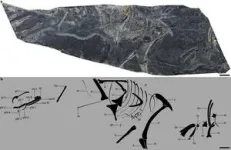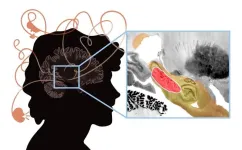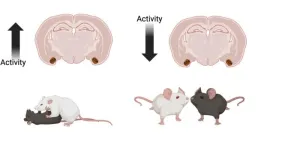(Press-News.org) The RNA inhibitor olpasiran significantly reduces a type of “bad cholesterol” that’s associated with a high risk of cardiovascular events, according to results from an analysis by a Mount Sinai researcher of a phase 2 trial. The study reported that higher doses of olpasiran lowered the type of cholesterol called lipoprotein(a) [Lp(a)] by more than 95 percent in participants with atherosclerotic cardiovascular disease. Findings were published February 12, 2025, in JAMA Cardiology.
“Our study is the first clinical trial to investigate the association between oxidized phospholipids on lipoprotein(a) and inflammatory mediators,” says Robert Rosenson, MD, Professor of Medicine (Cardiology) at the Icahn School of Medicine at Mount Sinai and lead author of the analyses. “We found that in addition to its beneficial effects on lowering lipoprotein(a), olpasiran reduced levels of oxidized phospholipids, which are presumed to promote atherosclerosis.”
Lipoprotein(a) is believed to be a major carrier of oxidized phospholipids, considered a potent driver of inflammation and atherosclerosis. Olpasiran (manufactured by Amgen), a small interfering RNA, blocks Lp(a) production by inducing degradation of apolipoprotein(a) messenger RNA (mRNA). Apolipoprotein(a) is a major protein component of lipoprotein(a), along with apolipoprotein B (apoB).
OCEAN(a)-DOSE, the randomized phase 2 clinical trial, enrolled 282 patients with cardiovascular disease and Lp(a) levels greater than 150 nmol/L (60 mg/dL)—levels that are believed to promote clotting and inflammation, significantly increasing the risk of heart attack, stroke, aortic stenosis, and peripheral artery disease. The reason for that danger is that Lp(a) can accumulate in the walls of blood vessels, forming plaques that are similar to low-density lipoprotein (LDL), a known risk factor for cardiovascular events. In fact, Lp(a) is believed to carry a cardiovascular risk five to six times that of LDL cholesterol.
Specifically, the research team reported that patients who received 75 mg or higher of olpasiran every 12 weeks had a 95 percent or greater reduction in Lp(a) compared to the placebo group at 36 weeks. Moreover, at week 36, Lp(a) increased by an average of 3.6 percent in the placebo group, while there were substantial reductions of Lp(a) levels in all of the olpasiran groups. The rates of adverse events were similar in the olpasiran and placebo cohorts.
“Results of our trial revealed that olpasiran led to a significant and sustained reduction in oxidized phospholipids on apolipoprotein B,” notes Dr. Rosenson, who also is Director of the Metabolism and Lipids Program for Mount Sinai Fuster Heart Hospital, which enrolled the largest number of participants in the study of any site worldwide. “We observed no significant effects of olpasiran, however, on the secretion of the proinflammatory cytokine interleukin-6 or C-reactive protein compared to the placebo group.”
Dr. Rosenson credits his analyses with exploring, even challenging, the leading hypothesis of Lp(a)-associated risk for cardiovascular disease. “Further work is needed in this area,” he emphasizes, “but OCEAN will enable us to more accurately select patients for future trials who are likely to show an anti-inflammatory response from selective RNA inhibitors of lipoprotein(a).”
The trial was led by the TIMI Study Group and sponsored by Amgen, Inc. A phase 3 outcomes trial for olpasiran is now underway
Mount Sinai Is a World Leader in Cardiology and Heart Surgery
Mount Sinai Fuster Heart Hospital at The Mount Sinai Hospital ranks No. 4 nationally for cardiology, heart, and vascular surgery, according to U.S. News & World Report®. It also ranks No. 1 in New York according to Newsweek’s “The World’s Best Specialized Hospitals.”
It is part of Mount Sinai Health System, which is New York City's largest academic medical system, encompassing eight hospitals, a leading medical school, and a vast network of ambulatory practices throughout the greater New York region. We advance medicine and health through unrivaled education and translational research and discovery to deliver care that is the safest, highest-quality, most accessible and equitable, and the best value of any health system in the nation. The Health System includes approximately 9,000 primary and specialty care physicians; 11 free-standing joint-venture centers throughout the five boroughs of New York City, Westchester, Long Island, and Florida; and 39 multidisciplinary research, educational, and clinical institutes. Hospitals within the Health System are consistently ranked by Newsweek’s® “The World’s Best Smart Hospitals” and by U.S. News & World Report's® “Best Hospitals” and “Best Children’s Hospitals.” The Mount Sinai Hospital is on the U.S. News & World Report's® “Best Hospitals” Honor Roll for 2024-2025.
For more information, visit https://www.mountsinai.org or find Mount Sinai on Facebook, Twitter and YouTube.
END
An RNA inhibitor may effectively reduce a high-risk type of cholesterol in patients with cardiovascular disease
2025-02-12
ELSE PRESS RELEASES FROM THIS DATE:
Research spotlight: Mapping lesions that cause psychosis to a human brain circuit and proposed stimulation target
2025-02-12
Andrew Pines, MD, MA, a resident in the Department of Psychiatry at Brigham and Women’s Hospital and a researcher in the Center for Brain Circuit Therapeutics, is the lead author of a paper published in JAMA Psychiatry, Mapping Lesions That Cause Psychosis to a Human Brain Circuit and Proposed Stimulation Target.
Shan Siddiqi, MD, Assistant Professor of Psychiatry at Harvard Medical School and Director of Psychiatric Neuromodulation Research at the BWH Center for Brain Circuit Therapeutics, is the senior author of this ...
New study identifies brain region that can prevent aggressive social behavior and induce pro social behavior
2025-02-12
**MEDIA ADVISORY**
UNDER EMBARGO UNTIL: Wednesday, February 12 at 11am EST
Nature article entitled:
A critical role for the cortical amygdala in shaping social encounters
[https://doi.org/10.1038/s41586-024-08540-4]
Bottom Line: Neural activity in the cortical amygdala determines whether mice engage in aggressive or pro-social behavior
Results: By performing a network analysis on whole-brain activity of male mice, we identified the cortical amygdala – an olfactory cortical structure – as a key brain region in promoting aggression. This brain region is activated by olfactory cues from male mice and by aggressive ...
Telehealth may be closing the care gap for people with substance use disorder in rural areas
2025-02-12
Recognition of telehealth as an effective strategy for delivering treatment for substance use disorder (SUD) has raised hopes for improving access to this treatment in settings with limited transportation or when time constraints compromise regular use of consistent access to in-person substance use treatment.
But the findings from a team of researchers from the Virginia Center for Health Innovation, UCLA, RAND, and MedInsight, Milliman Inc., suggest that the promise of telehealth may vary by insurance and geography.
New research suggests that people who live ...
Stronger, safer, smarter: pioneering Zinc-based dissolvable implants for bone repair
2025-02-12
Monash research could transform how broken bones are treated, with the development of a special zinc-based dissolvable material that could replace the metal plates and screws typically used to hold fractured bones together.
Surgeons routinely use stainless steel or titanium, which stay in the body forever, can cause discomfort and may require follow-up surgeries. A new zinc alloy, designed by Monash biomedical engineers, could solve these problems by being mechanically strong but gentle enough to degrade safely over time while supporting optimal healing.
A study published today in Nature shows the research team’s innovative ...
Could peripheral neuropathy be stopped before it starts?
2025-02-12
An increase in high-fat, high-fructose foods in people’s diets has contributed to a dramatic increase in type 2 diabetes. This, in turn, has led to an increase in peripheral neuropathy — nerve damage, typically in the hands and feet — that causes weakness, loss of sensation and, in some, a stabbing, burning, or tingling pain. About half of people with type 2 diabetes are affected, and of these, about half experience severe neuropathic pain.
The damage begins as axons from sensory neurons begin to retract and disappear from the tissues they innervate. New research from the lab of Clifford Woolf, MB, BCh, PhD, director ...
China Jurassic fossil discovery sheds light on bird origin
2025-02-12
A research team led by Professor WANG Min from the Institute of Vertebrate Paleontology and Paleoanthropology (IVPP) of the Chinese Academy of Sciences has discovered two bird fossils in Jurassic-era rocks from Fujian Province in southeast China. These rocks date back approximately 149 million years. The fossils fill a spatiotemporal gap in the early evolutionary history of birds and provide the evidence yet that birds were diversified by the end of the Jurassic period.
This study was published in Nature.
Birds ...
Long-term yogurt consumption tied to decreased incidence of certain types of colorectal cancer
2025-02-12
Yogurt, which contains live strains of bacteria, is thought to protect against many types of diseases, with some reports indicating it could reduce risk of colorectal cancer. A new study led by investigators from Mass General Brigham finds that yogurt consumption over time may protect against colorectal cancer through changes in the gut microbiome. Using data from studies that have followed participants for decades, researchers found that long-term consumption of two or more servings per week of yogurt was tied to lower rates of proximal colorectal cancer positive ...
Ovarian cancer discovery could turn failed treatment into lifesaver
2025-02-12
University of Virginia Cancer Center researchers have explained the failure of immune checkpoint therapy for ovarian cancer by discovering how gut bacteria interfere with the treatment. Doctors may be able to use the findings to overcome this treatment failure and save the lives of thousands of women every year.
The new discovery, from the lab of UVA’s Melanie Rutkowski, PhD, speaks to the surprising ways that the microbiome – the collection of organisms that live on and inside our bodies – is vital not only to ...
DNA methylation clocks may require tissue-specific adjustments for accurate aging estimates
2025-02-12
“Our results suggest that forensic applications of DNAm clocks using non-blood tissue types will provide age estimates that are not as accurate as predictions based on blood, especially if using clocks algorithms trained on blood samples.”
BUFFALO, NY—February 12, 2025 — A new research paper was published in Aging (Aging-US) on January 3, 2025, in Volume 17, Issue 1, titled “Characterization of DNA methylation clock algorithms applied to diverse tissue types.”
Researchers ...
Tidal energy measurements help SwRI scientists understand Titan’s composition, orbital history
2025-02-12
SAN ANTONIO — February 12, 2025 —Southwest Research Institute (SwRI) scientists are studying Saturn’s moon Titan to assess its tidal dissipation rate, the energy lost as it orbits the ringed planet with its massive gravitational force. Understanding tidal dissipation helps scientists infer many other things about Titan, such as the makeup of its inner core and its orbital history.
“When most people think of tides they think of the movement of the oceans, in and out, with the passage of the Moon overhead, said Dr. Brynna Downey. “But that is just because water moves ...









